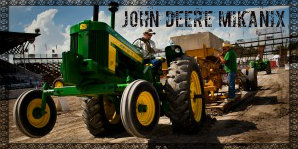Gear Pump Failure 313 and 317 Skid Steers No Hydraulics
The skid steer has experienced a sudden loss of main hydraulics. The boom and bucket will not operate and the park brake will not release. The 313 and 317 skid steers use an Eaton Series 26 gear pump. Pumps built prior to October 2008 had occasional problems with the heat treat process for the gears. If not properly heat treated, one or both gears can crack. Upon cracking, the gear expands outward, seizing to the aluminum pump housing. In many cases the pump shaft snaps off.
Pumps built after October 2008 have gears with an improved heat treat process. To determine the build date of an Eaton hydrostatic drive pump, look at the pump serial number. The pump serial number is interpreted as follows:
YYMMDDRBBXXXX
YY = the first two digits are the year. 08 is 2008, 09 is 2009, etc.
MM = the third and fourth digits are the month. 01 is January, 02 is February, etc.
DD = the fifth and sixth digits are the day of the month
RBB = Assembly plant. For our pumps RBB is Reynosa, Mexico. U is Hutchinson, KS. Since 2007 all skid steer pumps are Reynosa pumps.
The final four digits are the serial number. Serial numbers starting with 1 are first shift, those starting with 2 are second shift.
Thus, a pump with serial number 081015RBB2033 was built October 15, 2008 at Reynosa, MX. It was the 33rd pump built on second shift.
If your machine has experienced a cracked gear pump failure, it is important to repair it properly and economically. Below is the evaluation, repair, and cleanup procedure following a seized pump failure on the 313 and 317 skid steer.
1. Determine whether your pump was built before or after October 2008.
2. Examine the bushings in the front hydrostat housing.
a. If one or both bushings are damaged, complete hydrostat pump replacement is recommended. The bushings are not field serviceable.
b. If both bushings are undamaged, replace only the gear pump.
3. Because this failure mode is sudden and immediate, very little debris is generated and sent downstream. John Deere recommends the following cleanup procedure:
a. Remove the line(s) between the gear pump outlet and the control valve inlet. Thoroughly clean the line(s).
b. Remove and flush the attenuator, if installed.
c. Reassemble the machine.
d. Drain the hydraulic reservoir and visually inspect the interior of the reservoir for debris. If debris is found, add 1-2 gallons of diesel fuel to the reservoir and stir it around to loosen the oil and debris. Drain the fuel and use a shop vac to remove the last of the contamination from the reservoir.
e. Refill the reservoir and install a new hydraulic filter. If you have SuperCaddy or equivalent, filter caddy the oil. If you do not have SuperCaddy or equivalent, proceed to steps f through below.
f. Operate the machine for approximately 30 minutes driving forward and reverse and operating the boom and bucket cylinders through their full stroke.
g. Drain the hydraulic oil and change the filter again.
h. Check hydraulic flow and pressure at the auxiliary couplers. If flow and/or pressure are below spec, replace the system relief valve.
i. change the new hydraulic filter after 10 hours of operation.
Courtesy of John Deere DTAC Solutions
